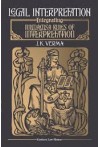- Author(s): J.K. Verma
- Publisher: Eastern Law House
- Edition: 1 Ed 2024
- ISBN 13 9789350353417
- Approx. Pages 662 + contents
- Format Hardbound
- Approx. Product Size 24 x 16 cms
- Delivery Time 3-5 working days (within Kerala & South India) (Others 7-9 days)
- Shipping Charge Extra (see Shopping Cart)
..................................................................................................................................................................................................................................................
Description
The legal fraternity in India has grown up reading P.B. Maxwell, F.W.L. Dwarris, Theodore Sedgwick, William Wilberforce, Craise, Rupert Cross, Bennion etc. on interpretation and taking firmly home the concept that only statutes needed to be interpreted. This conviction was reinforced by enactments like Interpretation Act 1889, Interpretation Measure 1925 and Statutory Instruments Act 1946. For this reason all available books on interpretation are variously titled as Interpretation of Statutes, Statutory Interpretation, Statute Law etc.
Many Indian authors have tried their hands at the subject trying to adopt and adapt Maxwellian principles into Indian conditions. Foremost of these authors is Justice G.P. Singh whose 'Principles of Statutory Interpretation' explaining, elaborating and enlarging but confining itself to the Maxwellian principles of statutory interpretation, rules the field and rightly so. Justice Singh has been alive to changing legal trends in India and has commented thereon copiously in his book. In the same vane he has mentioned the current debate on applicability of the ancient Indian Mîmâmsâ Rules of Interpretation in the preface to twelfth edition of his book but not dealt with it citing inadequate knowledge of the subject. This humility calls for respect and appreciation for the celebrated author.
In this backdrop writing a book on legal interpretation and yet avoiding the stamp of being run of the mill proved to be a herculean task for the present author. For a starter the author has broken away from the traditional structure and content of such books.
Being fascinated by the subject of Mîmâmsâ and therefore pursuing his research for the last several years, the author became more and more convinced that the Mîmâmsâ rules of interpretation or the Mîmâmsâ sûtras, if properly interpreted and applied, can largely aid and supplement our system of legal interpretation. For this, to borrow words of Justice B.N. Srikrishna, "Mîmâmsâ sûtras need to be formally reduced to universally identified rules". This author has attempted to do the same and thereby has commenced a beginning. His book "Interpreting Law with Mîmâmsâ Sûtras" codifying the Sûtras into 109 Rules of interpretation has been published and these codes or the Rules have been freely and copiously used in this book for supplementing the prevailing system of interpretation.
..................................................................................................................................................................................................................................................
Contents
Chapter 1. Introduction
Chapter 2. The Law
Chapter 3. General Features of Enacted Law
Chapter 4. Textual Interpretation
Chapter 5. Contextual Interpretation
Chapter 6. Secondary Principles of Interpretation
Chapter 7. Aids to Interpretation
Chapter 8. Constitutional Interpretation
Chapter 9. Interpretation of Particular Statutes
Chapter 10. Interpretation of Judgments Etc.
..................................................................................................................................................................................................................................................
Author Details
J. K. Verma

